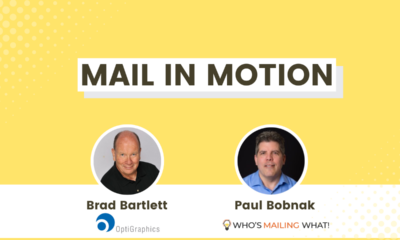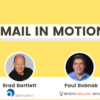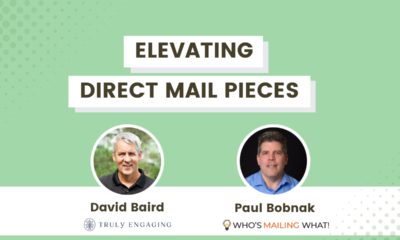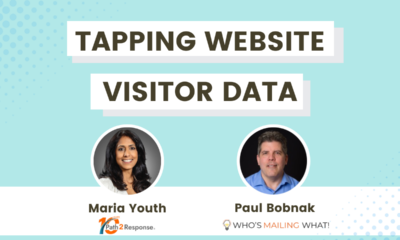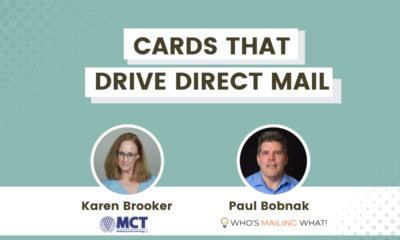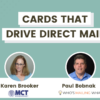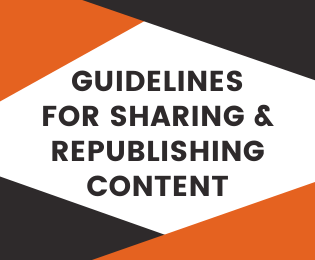MEET THE MAILERS
Meet the Mailers: Smart Audience Targeting
In this episode, I talked with TRAK Data about challenges faced by marketers today, good news about 3rd party cookies, and effective lookalike modeling.
In this episode, I talked with Jessica Akinwale, Co-Founder of TRAK Data. TRAK Data is a direct mail and digital marketing agency that helps brands maximize growth and improve profitability by making advanced data-driven targeting solutions accessible to all marketers.
Much of our discussion centered on how to optimize data in your marketing strategy.
One way is to choose what you know about an audience – potentially thousands of data points – to create generalized but still targeted messages:
I’m still going to resonate with it and it’ll still hit my needs, but it wouldn’t be considered creepy.
 Jessica Akinwale Co-Founder
Jessica Akinwale Co-Founder
TRAK Data Inc.
Here are some of the other topics we covered:
- Her background in direct mail
- Challenges faced by marketers today
- The good news about 3rd party cookies
- Effective lookalike modeling
- Tips in VDP
- Trends in direct mail
Here are some questions and answers (edited for clarity and space):
- Data hygiene should be a given for any size company, but for too many, it’s not. What should companies be doing to clean and maintain good data?
This is a very important question because there are two parts of this.
One, data hygiene that should be taken on a regular basis with your customer data and the other side is data hygiene that should be taken before an actual campaign, so before you use that data for your direct mail program.
Let’s give an example. Think like an in-store furniture retailer, where you’re working with salespeople and the sort of staff or employee at the retail location is inputting the customer’s information themselves is bound to have improper formatting at times, probably a lot of holes. Maybe they didn’t put visit for, they just put those up. I mean, when we’re inputting data manually, it’s bound to have errors. So to sort of fix that on an ongoing basis, you can match your customer data to third-party data files, like Acxiom or Experian data like we have at TRAK to fill those holes.
So if we match Jessica Akinwale to third-party data from 123 Main Street, maybe Zip 4 was missing – they’ll fill that in. Maybe my name was misspelled – it’ll correct that. So to kind of fill those holes in the data.
And then from a campaign perspective, there are a few processes you should definitely take before you execute a direct mail campaign.
One is NCOA verification (National Change of Address) and ensure your data’s up-to-date. This can be done monthly, for example, just run your data through this process to make sure it’s the most accurate. Then the same thing with CASS standardization, get your data in a format that’s going to work best with the USPS for your postage.
Make sure you have the Zip 4 again, fill any holes and you can do all of that by, again, matching your customer data to that third-party data file.
Last but not least is deduping. All the amount of money I see brands waste at times because they don’t dedupe their own customer file or their own direct mail list.
You might send two catalogs to the same household because Jessica Akinwale and Jess Akinwale were inputted twice into the system. So simply deduping will save a ton of money.
- With third-party cookies going away, more or less, companies have to look for other sources to supplement or enrich their data. What are your thoughts about that? And what effect will this have on direct mail?
Yeah, that’s a good one cause it is very prevalent right now, the top of this and the industry.
And the good news is direct mail is not going to necessarily be affected or at least in the way one might think. And that was because direct mail we can consider [is] the first real addressable media. Where again, Jess Akinwale at 123 Main Street, first name, last name, address, you know where to find me, there’s third-party data tied to that.
Then with the growth of online, you know, cookies became a really easy way to kind of track, monitor activity, follow your visitors and customers across sites and channels, etc. But with that growth online, these huge identity resolution companies started to map and resolve all of those different identifiers.
The cookies and the IP addresses and emails and phone numbers … match those back to Jess Akinwale at 123 Main Street, so kind of resolve them back to an individual record. Even with cookies going away, if your foundation is direct mail, or if your foundation is offline data, you can still, regardless of cookies, send me a direct mail piece, load me to your Facebook Business Ads Manager campaign for a social campaign, match me to your DSP or your DNP for online, even for OTT for television, regardless of cookies, you can still find me and your prospects everywhere across channels. So it’s good news for direct mail.
- Can you talk about the role of modeling such as lookalike in a direct mail strategy or campaign?
Yes, absolutely. So, if we focus on lookalike modeling, given that it’s the overwhelmingly most common model approach for direct mail, I’d say, I think that’s just because of its ease of access and the requirements needed for lookalike modeling are low. You simply need a list of your current customers and then you can build a lookalike model with a partner.
[L]ookalike modeling, I guess that’s described by comparing it to the alternatives. So without a model, you can create a list of prospects using, at the most basic level, let’s say demographics and geography – people who live within your trading area or your target Zip codes. That’s one.The second would be using all of that third-party data I’ve mentioned. So thousands of data points on each person, national scale and population to say, okay, do I want to find people who have young kids in the home, who make 100-150 grand a year who live in these places, who are interested in travel. You can use all of those data points to identify your target prospect audience.
And let’s say there are 20 million people nationally who fit your required filters. You would then pull from that 20 million the hundred thousand you want to mail and go with that. So still much more targeted than nothing, but there is still some guesswork where we still had to choose the filters ourselves. I still didn’t know the best hundred thousand, I just went within the available 20 million to find them.
Lookalike model takes away any of that guesswork or sort of gut feelings that go into it because the model will analyze all of the available variables and tell us the exact combination of those variables and weights of those variables to use, to find the best prospects.
And what that process looks like is, we would take – or whoever’s building this model – would take in a list of current customers, match those customers to third-party data, so now you know, Paul and Jess are customers, and here are the 1500 data points on each of them. And the model will analyze that and come back with that recipe, like I mentioned, of the best combinations of variables to find new prospects who look just like Paul and Jess.
The benefit of this is the output is a scored file, so instead of again us choosing within 20 million people, the random hundred thousand to mail, the output of this model is a scored file of literally 1 to 250 million everyone nationally on how closely they fit the model, meaning how good of a prospect are they? How much do they look like Paul and Jess?
- What are some good tips for marketers to put together a variable data printing (VDP) campaign?
And the benefit of that is you’re targeting the person anyways but when you receive a mail piece, it’s tangible, it’s in your hand, you’re taking a second. The benefit of just adding that person’s name and information to it, is there in terms of the response and the ROI you’re going to see with the campaign. But beyond that, there are the possibilities [that] are endless with these types of campaigns.
You can go as far as segmenting your current customers and based on the actions they take with you, the company themselves, you can send them custom mail pieces. For example, let’s say my neighbor and I are both interested in travel and I might get a postcard from this travel company that has a young or middle-aged family with kids on a beach because that’s what I’m interested in.
And they might get from the same company during the same campaign period an ad with adventure travel with older kids because that’s what they’re most interested in. That can all happen kind of in real-time throughout a campaign process where there are different images, different offers, personalization again with the name and address that can be printed based on the information you have about that prospect.
The last thing on these campaigns is I’d say I just mentioned a lot of information, but it’s not a requirement. You don’t need to have complex processes and massive CRMs and all this data in-house to leverage these types of campaigns. At a minimum, again, put the name and address on there, you’re targeting them anyways.
Maybe you could customize based on general interests or life stage. But the possibilities are endless.
- What do you think that the trends for direct mail for the next year or so are going to look like?
VDP printing, like you said, that variable data printing, I think is going to be used more and more as personalization becomes more attainable to all brands.
One of the things we’re trying to do, at least at TRAK, is to give this level of data to companies regardless of size. If you can just find out a few more data pieces, it doesn’t have to be thousands, it can be 10, it can be demographics on your customers or on your prospects – you can really improve the level of targeting and therefore engagement and response you’re seeing on a campaign.
I think just more direct mail would be a trend. I’m seeing a lot more brands come back to it or try it for the first time, given those changes in the online space as well.
And I guess measurement and cross channel being the last sort of trend, meaning, again, you have the individual records, so for measurement and attribution, life is so much easier, you know who responded, you know who didn’t. But in terms of cross channel, again, their ROI is already higher with direct mail, but when you include another channel, so you send me a direct mail piece, but also load me to your Facebook, and run some Facebook impressions against me during the campaign period, or send me an email, or load me to your DSP for online cross channel. Multi-channel campaigns with direct mail at the root, for the foundation, are taking off, I would say, and the results are supporting that.
Here is our conversation. We’ve added timecodes for your convenience.
Thank you again, Jessica, for an interesting and informative chat! To learn more about TRAK Data, visit TrakDataInc.com.
Your comments and ideas are very important to us in making your Who’s Mailing What! experience even better for you. Through these engaging talks, we hope you’ll take away practical tips, insights, and stories to inspire and build your own success.
If you have any feedback — or are interested in sharing your expertise with our wide and diverse audience — please reach out to me. I’d love to hear from you!







